Email Marketing
Retail Email Marketing Strategy: Keys to Success in 2024
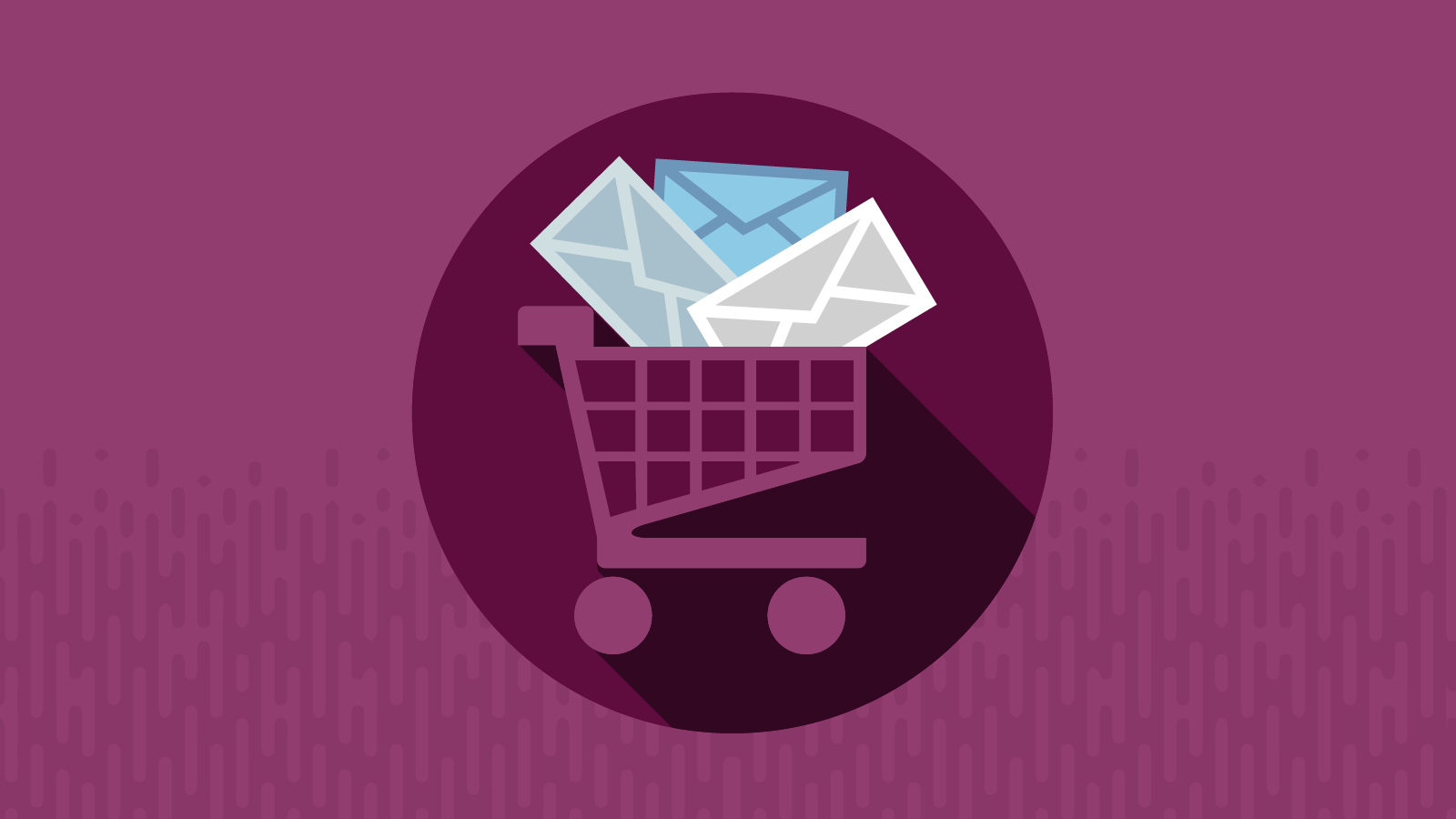
Email Marketing

The email inbox is one of the best places for retailers to connect with customers. But, because it’s so effective, retail email marketing is also challenging and competitive.
Deals! Coupons! Discounts! Codes! That may be what shoppers want. The only problem is, practically every retailer is sending them the same thing. You would never shout at customers in your retail store to “buy now before it’s gone!” Yet that’s exactly what many retail email marketers do.
It’s time to make email work for your retail business. Email has one of the highest returns on investment of any marketing channel out there, especially for retail.
That’s why our friends at Sinch Mailjet asked more than 2,000 consumers about their email marketing preferences for the 2024 Path to email engagement report. In this article, we’ll share some insights from the survey and offer advice for a retail email marketing strategy that cuts through the clutter.
Customers no longer “go shopping” as a verb the way they did in the mall hey-days of the early aughts. With the exception of grocery items and foodstuffs, shoppers often turn online first.
Retail industry research shows 39% of consumers say they “can’t live without online shopping.” Even if they do visit a store IRL, they’re still split on how they purchase, with 53% telling Shopify that they’re likely to look at an item in a store before buying online (or vice-versa.)
It doesn’t matter whether you’re running a primarily brick-and-mortar business or operate 100% online. Shoppers expect a cohesive brand experience – and that’s exactly what email marketing can do. While email is technically a digital marketing channel, it’s a much more personal experience than other marketing channels. Retail brands can build relationships with customers through the inbox, increasing loyalty and repeat purchases.
Of course, the email channel also has functional purposes for retail brands. Transactional emails are unsung heroes that improve the customer experience. Online shoppers rely on and expect things like order confirmations, shipping updates, and other messages that help your retail brand conduct business online.
Part of why email marketing is so powerful? Because your customers want to hear from you there. Sinch Mailjet found around three-quarters of consumers prefer email marketing for both transactional and promotional messages.
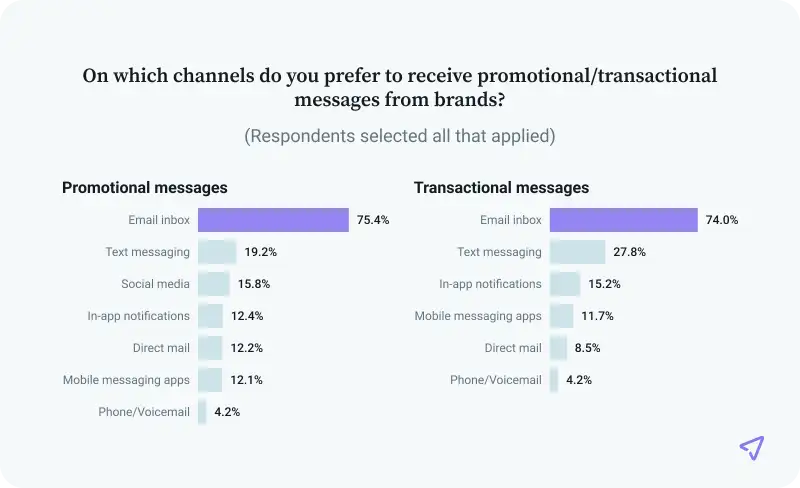
These types of messages are very different but both critical for your retail email marketing strategy:
Transactional emails relate directly to the completion of a sale, such as email receipts, shipping confirmations, or return information. These emails are sent based on specific actions from the customer and are limited in scope. If it’s a true transactional email, retailers don’t need an opt-in to send it because the transaction indicated implied consent.
Promotional emails include every other kind of email you would send to a customer or prospect – such as deals and upcoming sales, showcasing new arrivals, or recommending new products. These emails are sent to all (or a segment) of your email list and can be customized for just about anything. Mailjet’s survey found 62.8% of consumers say exclusive deals and offers are the most valuable thing they get from B2C brand emails.
There are some messages that blur the lines between transactional and promotional. For example, abandoned cart emails seem related to a transaction. However, since cart abandonment and the followup email happen before a purchase, it’s more about pushing for the sale. That’s promotional.
On the other hand, welcome emails can be a transactional email when they’re triggered by an initial purchase or account creation. Above all, retail email marketers should avoid adding too much promotional messaging into transactional emails.
Whether you’re operating an ecommerce or brick-and-mortar retail business, email marketing should be a major part of your strategy. Let’s talk through some of the building blocks for sending strong, relevant email marketing campaigns to your subscribers so they’re more likely to buy from you:
Of course, to make the most of email as a channel, you’ll need to build your email list first. Shoppers sign up for emails primarily because they’re interested in receiving regular deals and or one-time discounts.
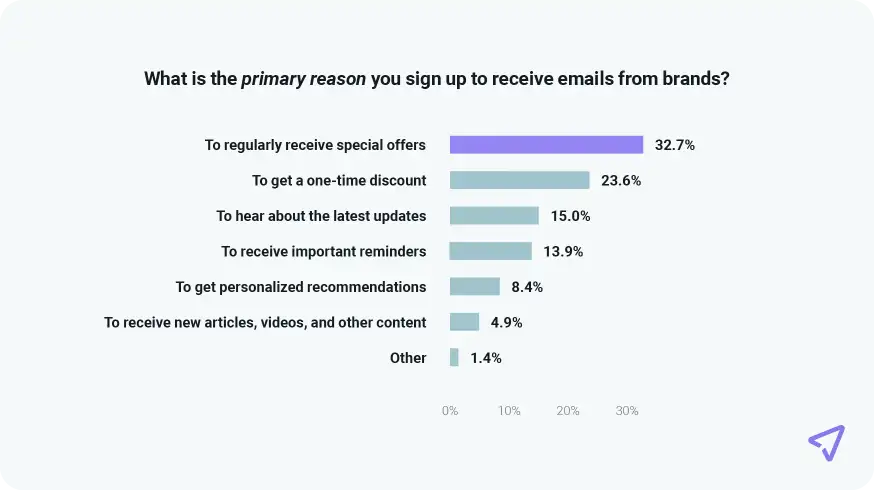
In retail, that means focusing on two key areas of the customer journey:
For both, make sure customers understand the value they receive by giving their email address.
Do they have access to a new account where they can collect loyalty points, get special deals, or receive free shipping? Will they be saved from having to enter all their details again? Do they get access to a special experience in your store?
Your customers know that you’ll be emailing them. Make it worth their while.
What separates annoying email campaigns from exciting ones for subscribers is a laser-focused, highly targeted segmentation strategy. Email list segmentation is as much about avoiding email fatigue as it is about sending highly relevant communications.
Every email that you send that doesn’t positively engage a subscriber risks your future relationship with that subscriber.
Email lists can be segmented in many different ways. The most obvious way to segment your lists is based on previous purchases and perceived customer personas for email marketing. For example, a gaming retailer who previously sold a customer an Xbox console may find very little success if they start sending that same customer emails relating to PlayStation games and accessories. Knowing who you plan to target before you send an email pays off in the long run.
Segmentation is the first step toward sending more relevant emails to your shoppers, but it’s personalization that takes it to the next level. Mailjet’s survey found more than 80% of consumers view personalized content as important when deciding whether to open a B2C email campaign.
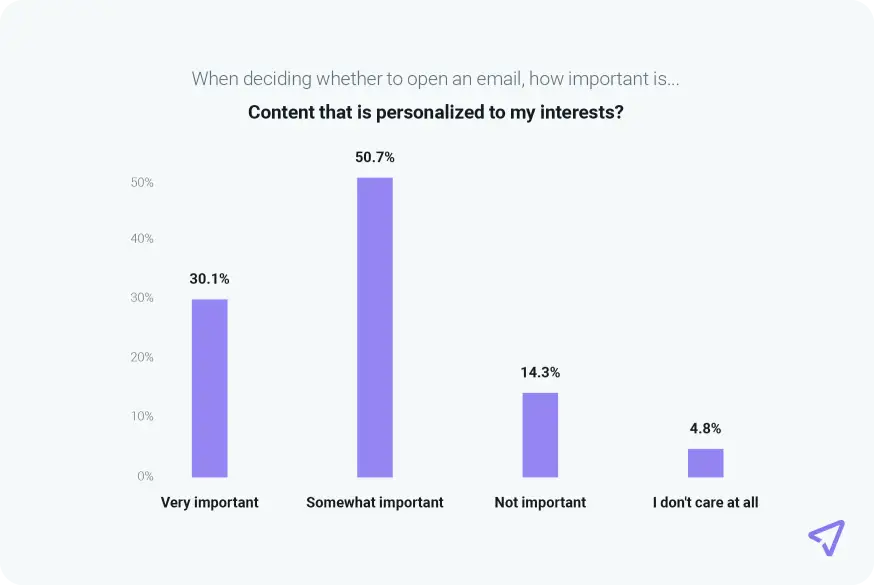
While addressing shoppers by their first name is a great start, they expect more from you.
You’re already collecting tons of data on your shoppers, from what kinds of products they purchase to which items tend to be paired together in their carts. Use data on past purchases, content consumption, and website browsing to your advantage. Something as simple as a birthday email can inspire brand loyalty.
If you want to drive sales with your email marketing campaigns, then your shoppers have to open your email in the first place.And inboxes are crowded already with your retail competitors. How can you stand out and improve your open rates?
Writing compelling subject lines matters for your metrics, but your brand’s reputation and anticipation about what’s inside the message are also key considerations for shoppers. In fact, 94.5% said recognizing the sender or brand was at least somewhat important when deciding whether to open emails. Around two thirds of consumers said the same about subject lines promoting a limited time offer.
Once they open your retail email promotion, the next step is convincing consumers to click. More than 45% of survey respondents told Mailjet the chance to use a coupon code or claim a deal. However, wanting to learn more about what was in the email or the chance to check out a featured product were also popular reasons for clicking.
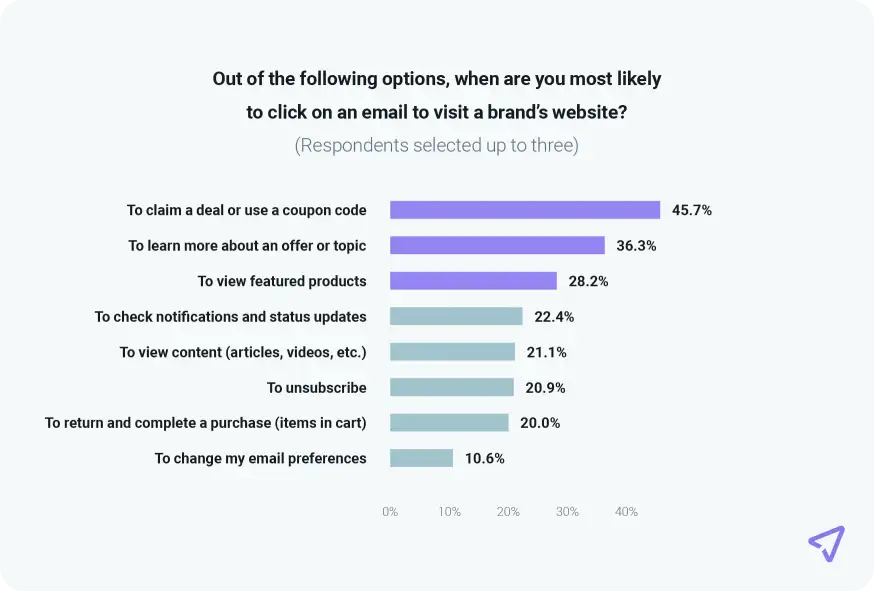
To increase clicks, make sure you generate some curiosity with your retail email marketing. You want subscribers to be interested enough to click that CTA button because they just have to know more.
What about the Gmail Promotions tab? Don’t panic! Landing there is nothing like ending up in spam. In fact, it may even give you an advantage.
According to Sinch Mailjet, more than 50% of shoppers who use Gmail check their Promotions tab every day. Let’s be honest, if you’re sending promotional emails, the Promotions tab is where you belong. Gmail may actually be helping you out here. It organizes emails for users and helps you avoid getting lost in the main inbox. If an email user visits their Promotions tab, it’s a sign they’re willing to start shopping. And that’s a good thing if you’re a retail email marketer.
There are also ways to optimize retail emails for the Gmail Promotions tab. You can use Schema markup to showcase coupon codes, deal expiration dates, product carousels and more. This happens at the inbox level – before people even open the campaign.
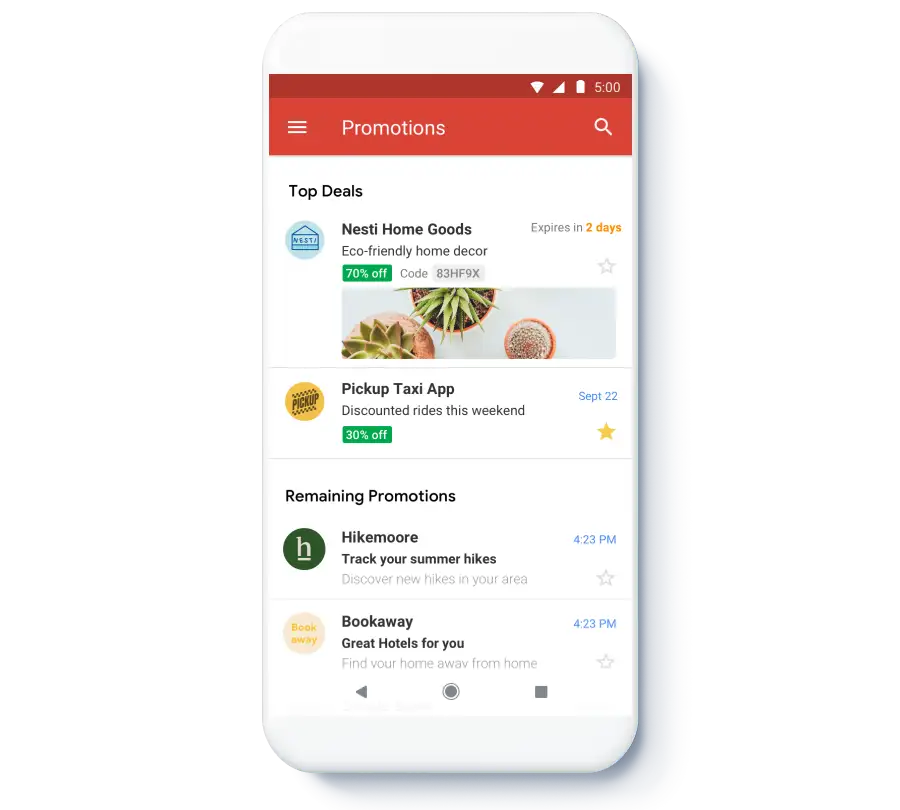
Need a little inspiration for your retail email marketing efforts? We got you. Here are some of the most common types of emails retailers send:
Welcome emails are a classic email automation that can kick off a great relationship with a customer without a lot of effort. Your welcome email should clearly set up what kinds of emails you plan to send your subscribers so they know what to expect from you. New customers want to feel good about their purchase, too.
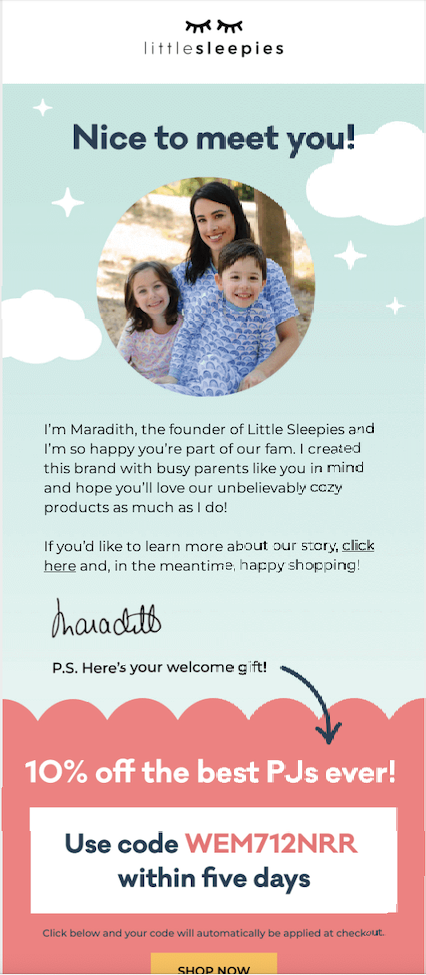
While not every welcome email needs to include the founder like this one, it makes sense for Little Sleepies, a family sleepwear brand. The more personal you can make your welcome, the better. (And a discount doesn’t hurt, either.)
Shoppers say they sign up for emails because of deals, but talk too much about discounts and you’ll only cheapen your brand. Instead, sprinkle in educational content that matches what you offer. For example, a food retailer might want to share recipe ideas to sell more seasonal ingredients. Similarly, a sports store might want to share tips about improving a customer’s sporting performance and how specific products can help them find those marginal gains.
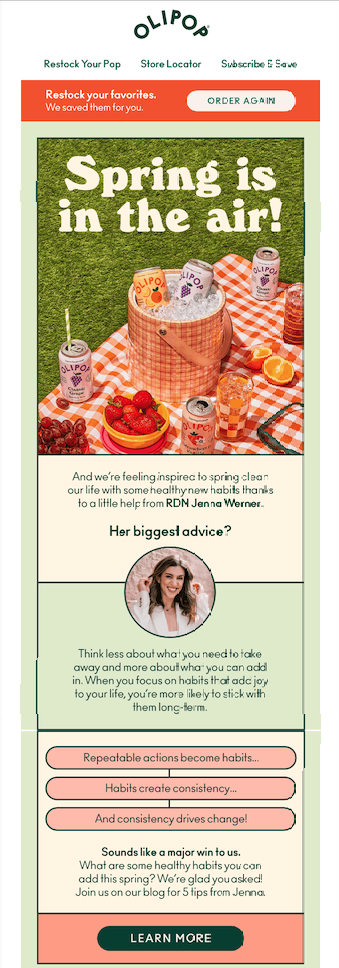
This example does a great job of promoting a new product release without really promoting it, instead offering wellness tips that align with their brand. When a retailer positions themselves as a thought leader, they’re much more likely to build a loyal fan base of customers than those who only promote deals. You can still include a CTA to shop in your email design, though it should be less prominent than a product-specific email.
Never underestimate the importance of sharing useful information with your community of customers. Emails highlighting changes to store opening hours, new store locations, and essential information about store operations (particularly during the ongoing pandemic) are incredibly important for setting customer expectations and building relationships. This information gets included in special announcement emails as well as a retail brand’s regular email newsletter.
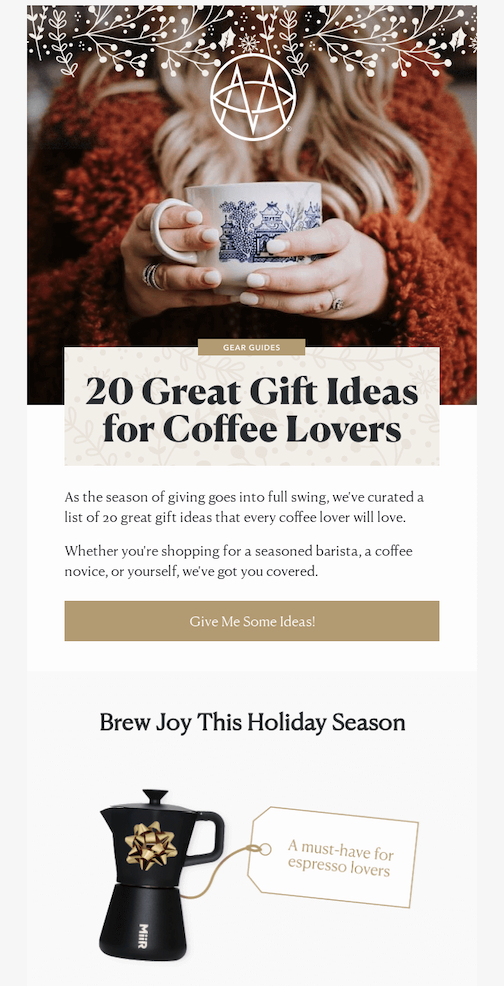
Gift guides like this one are a great example of this. You’re communicating something that customers are interested in hearing more about (especially during the busy holiday season) while promoting your products. Win-win.
Retail email marketing strategy thrives on seasonal promotions, whether it’s curating an all-green lineup for St. Patrick’s Day or sending out summer swimwear for spring break. But the biggest seasonal promotion of them all? Black Friday and Cyber Monday.

While you’ll have a slate of emails for the entire season planned out to follow-up your original campaign, keep it as simple as possible, like this example.
While promotional emails get all the glory during BFCM, remember that your transactional emails matter, too. When Sinch Mailjet asked shoppers about confirmations and shipping updates during the busy holiday shopping season, more than 80% of consumers said transactional communication is either very important or somewhat important.
Some of your shoppers eagerly await your next drop. Others have no idea a product launch is happening. Either way, sending an email for new product releases, especially if they’re seasonally appropriate, can help you encourage repeat purchases. These emails are a great place to include personalized product recommendations based on purchase history as well.

This email example showcases what could be a very boring flavor (vanilla) in an exciting, eye-catching way. From swirling design to calling out the fact that most people think vanilla is boring (and explaining why it’s not), this is an email that makes you want to buy.
Abandoned carts are a common online behavior these days (can you imagine what your store would look like if everyone left behind shopping carts in person?) Sending a quick automated email to your shoppers to let them know they’ve left something behind can be a great way to tip them into making the purchase.

Cart abandonment emails like this one don’t need to be interactive to make an impact. This email is a great example of staying true to your brand, even if it’s a triggered email. Bonus points for creating a personalized email with the actual item the shopper left behind in their cart.
Because order confirmation emails are transactional in nature, retailers are more limited in what they can include – but you can still make them easy to understand and pleasing to the eye. Obviously, you’ll want to make sure there’s a clear confirmation of the order, the cost, and any shipping details you’re able to provide up front.
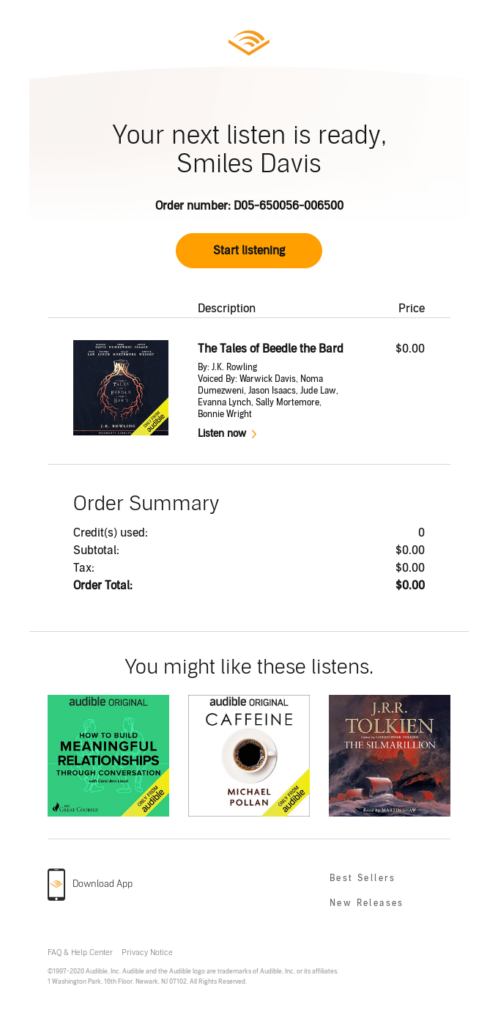
Audible does a great job of including what an order confirmation needs to have (credits used, total cost, etc.) while adding a little bit of flair at the bottom with a few recommended next listens.
Shoppers want to know when you’ve shipped an item and when they should receive it. In today’s retail world of get-it-same-day, the more you can communicate about the status of their package, the better.
This is also true of merchandise – especially if there’s an item you know a shopper has been looking at or is already in their cart. Sending a “back in stock” email to subscribers who have been poking around certain product lines is a great way to underline urgency and get them to purchase right away.

This example does a great job of promoting urgency (sold out 3x!) and making shoppers feel special that they have access to order now.
Few customers make it to the ideal conclusion of the customer journey: Raving about your product online post-purchase. Make it easy for them to let others know how you did with a targeted customer feedback email. For these, you want to get them to your review platform of choice as quickly as possible, whether it’s on your own site or through a third-party service.

This example keeps it short and simple, with a clear call to action up front to leave a review.
A robust retail email marketing strategy drives customer engagement and brand loyalty. Retail email marketers regularly use email to execute certain details of a customer rewards program, notifying subscribers about points earned and how to take advantage of them. Remember, these are your loyal customers – an incredibly valuable segment to your retail business’ bottom line.

This email is a great example of how to showcase perks for customer loyalty programs, clearly stating the current balance at the top while detailing each freebie in a fun, eye-catching design.
One thing you may notice about a lot of retail email marketing campaigns is that they often rely quite a bit on eye-catching design and unique layouts. What you may not realize is that some email clients and mailbox providers may be messing all of that up for your brand.
Emails render differently on different clients and devices. That means your email may look great in your drag-and-drop WYSWIG editor, but it could be a hot mess in Gmail, Outlook, or Yahoo Mail inboxes, or it could look be unreadable in dark mode.
That’s why you’ve got to test and preview every retail email campaign before you hit send. Sinch Email on Acid offers reliable email previews on more than 100 live clients and devices as well as many other pre-send checks to help retail marketing teams with email quality assurance. Gain send-button confidence with our industry-leading platform and make sure your retail email marketing lands in consumers’ inboxes looking like a million bucks.